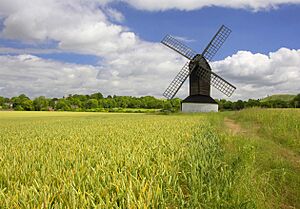Pitstone Windmill facts for kids
Quick facts for kids Pitstone Windmill |
|
|---|---|

The windmill in 2008
|
|
| Origin | |
| Grid reference | SP 945 147 |
| Coordinates | 51°49′54″N 0°37′48″W / 51.8317°N 0.6299°W |
| Year built | 1627 |
| Information | |
| Purpose | Corn mill |
| Type | Post mill |
| Roundhouse storeys | Single storey roundhouse |
| No. of sails | Four |
| Type of sails | Common sails |
| Winding | Tailpole |
| Other information | Grade II* listed building |
Pitstone Windmill is a very old and special windmill located in England. It's considered a Grade II* listed building, which means it's an important historical site. People believe it was built a long time ago, in the early 1600s. You can find it in a big field near the villages of Ivinghoe and Pitstone in Buckinghamshire. Today, the windmill is cared for by the National Trust, a charity that protects historic places.
Contents
The Story of Pitstone Windmill
How Old Is It?
Many people think Pitstone Windmill was first built around 1627. This date is carved into some of its wooden parts. It's the oldest date found on any windmill in the British Isles.
However, windmills needed lots of repairs over time. So, parts of this mill might be even older than 1627. Scientists used a method called dendrochronology in 2004. This method studies tree rings to find out how old wood is.
They found that some of the oldest wood in the mill came from trees cut down in the late 1590s. Other parts, like a "new" main beam, were from trees cut in 1670. Some pieces were even from the 1820s! This shows that the mill is a mix of very old and newer timbers.
Grinding Grain
For almost 300 years, the windmill was very busy. It ground grain from the nearby villages into flour. This was a vital job for the local farmers.
In 1874, a wealthy landowner named Adelbert Wellington Brownlow Cust bought the mill. He was the 3rd Earl Brownlow and owned the large Ashridge Estate. He later let a local farmer run the mill, and it became a successful business.
Damage and Restoration
In 1902, a huge storm hit the area. The windmill was badly damaged, so much so that it was too expensive to fix. It stood empty and ruined for many years.
Around 1922, a farmer whose land was near the mill bought the damaged structure. In 1937, he generously gave the windmill to the National Trust.
It took a long time for the mill to be repaired. In 1963, a group of dedicated volunteers started working on it. They even paid for the repairs themselves! Their hard work brought the old mill back to life.
The windmill even appeared on TV! It was featured in an episode of a show called The Champions in 1967. Finally, in 1970, after 68 years, Pitstone Windmill was able to grind corn again.
Today, you can visit the windmill on summer Friday afternoons.
How Pitstone Windmill Works
A Post Mill Design
Pitstone Windmill is a special type of windmill called a post mill. This means the main part of the mill, which holds all the machinery, sits on a huge central post.
This strong post goes from the ground up through a brick base. The entire wooden body of the mill, along with its sails, can turn around this central post. This allowed the mill to always face the wind, no matter which way it was blowing.
Turning the Mill
In the 20th century, some extra supports were added. These supports stopped the top part of the mill from turning.
To get inside the part of the mill that used to rotate, people would climb a set of steps on the outside. Inside, the mill's machinery would grind the grain.


